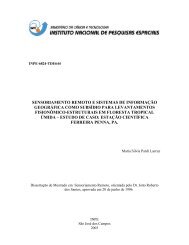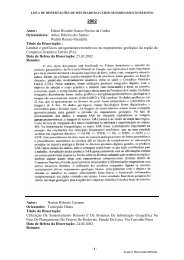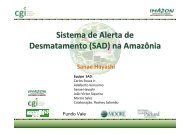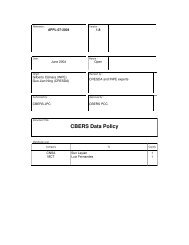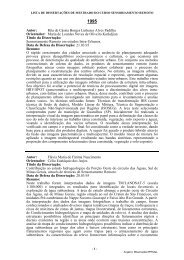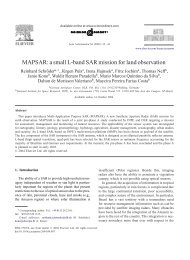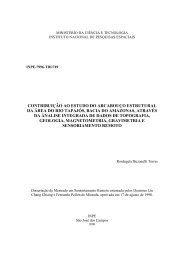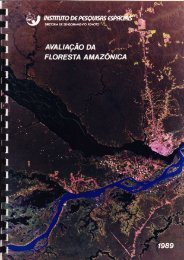RESUMO O objetivo deste trabalho é identificar áreas de ... - OBT
RESUMO O objetivo deste trabalho é identificar áreas de ... - OBT
RESUMO O objetivo deste trabalho é identificar áreas de ... - OBT
You also want an ePaper? Increase the reach of your titles
YUMPU automatically turns print PDFs into web optimized ePapers that Google loves.
<strong>RESUMO</strong><br />
O <strong>objetivo</strong> <strong><strong>de</strong>ste</strong> <strong>trabalho</strong> é <strong>i<strong>de</strong>ntificar</strong> áreas <strong>de</strong> <strong>de</strong>slizamentos utilizando variáveis<br />
geomorfológicas (principalmente as morfométricas) extraídas por técnicas <strong>de</strong><br />
processamentos <strong>de</strong> dados <strong>de</strong> sensoriamento remoto e sistema <strong>de</strong> informações geográficas<br />
(SIG) Este estudo foi <strong>de</strong>senvolvido em um setor da Serra do Mar, no município <strong>de</strong><br />
Caraguatatuba (Estado <strong>de</strong> São Paulo), a qual é susceptível a movimentos <strong>de</strong> massa. Neste<br />
estudo foram utilizados dados TM Landsat, fotografias aéreas e mapas topográficos.<br />
Técnicas <strong>de</strong> processamento <strong>de</strong> imagens como ampliação linear <strong>de</strong> contraste, filtragem<br />
espacial, razão e multiplicação entre bandas e transformação por componentes principais<br />
foram aplicadas <strong>de</strong> forma a <strong>de</strong>stacar elementos relacionados a <strong>de</strong>slizamentos. A<br />
composição colorida TM 473 RGB foi a que mais contribuiu para a distinção <strong>de</strong> diferentes<br />
cicatrizes <strong>de</strong> <strong>de</strong>slizamentos. As composições coloridas com componentes principais 321<br />
RGB e razão entre bandas 5/7 4/3 4/1 RGB <strong>de</strong>stacaram as cicatrizes e as feições antrópicas.<br />
A composição colorida com multiplicação entre bandas 5x4 2x4 7x4 RGB <strong>de</strong>stacaram as<br />
feições do relevo.<br />
As variáveis geomorfológicas (altitu<strong>de</strong>, amplitu<strong>de</strong> altimétrica, <strong>de</strong>clivida<strong>de</strong>, aspecto, formas<br />
<strong>de</strong> vertentes e <strong>de</strong>nsida<strong>de</strong> <strong>de</strong> drenagem) foram extraídas tanto <strong>de</strong> Mo<strong>de</strong>lo Numérico <strong>de</strong><br />
Terreno (MNT) quanto a partir da interpretação e análise das imagens. Através <strong>de</strong> SIG<br />
foram obtidos os índices morfométricos e a integração <strong>de</strong> dados, <strong>de</strong> forma a gerar um mapa<br />
<strong>de</strong> áreas <strong>de</strong> risco <strong>de</strong> movimentos <strong>de</strong> massa. Muitos dos resultados obtidos mostraram-se<br />
compatíveis com os resultados obtidos por outros autores e através <strong>de</strong> outras abordagens,<br />
para a mesma área <strong>de</strong> estudo.
GEOMORPHOLOGICAL VARIABLES FOR LANDSLIDE ASSESSMENT IN<br />
CARAGUATATUBA-SP USING LANDSAT – TM IMAGES AND GIS<br />
ABSTRACT<br />
The objective of this study is to i<strong>de</strong>ntify landsli<strong>de</strong>s areas using geomorphological variables<br />
(mainly morphometric) <strong>de</strong>rived from both remote sensing data processing and Geographic<br />
Information Systems (GIS) techniques<br />
This study was carried out on a sector of Serra do Mar in the municipality of<br />
Caraguatatuba (São Paulo state) subjected to mass movement hazards. Data from Landsat-<br />
TM, aerial photography and topographic maps were used in this study. Image processing<br />
techniques such as linear contrast stretch, spatial filtering, image ratioing and multiplication<br />
and principal components transformations were applied to enhance features related to<br />
landsli<strong>de</strong>. The colour composition TM 473 RGB contributed most effectively to<br />
discriminate landsli<strong>de</strong> scar differences. The both colour compositions with principal<br />
components 321 RGB and ratio band composition 5/7 4/3 4/1 RGB highlighted antropic<br />
features and landsli<strong>de</strong> scar. The colour composition with band multiplication 5x4 2x4 7x4<br />
RGB highlighted relief features.<br />
Geomorphological variables: elevation, slope gradient, slope aspect, slope form and<br />
drainage <strong>de</strong>nsity were extracted from both a Digital Elevation Mo<strong>de</strong>l (DEM) and image<br />
analysis. GIS techniques were used to <strong>de</strong>rive morphometric indices, to data integration and<br />
to obtain a landsli<strong>de</strong> hazard map. Most of the results obtained agree with those obtained by<br />
other authors and other approaches used in the same region un<strong>de</strong>r study.



